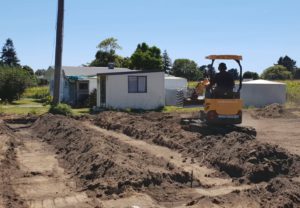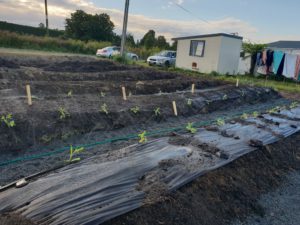
We got to a point where the section was finally cleared of unwanted structures and weeds including the kiwifruit vine. The ground was very uneven and pitted in places so we evened it out using a bobcat. We also took the whole of the perimeter fence down which was old and not functional anymore. Then two weeks ago we hired a mini digger to construct the swales and to build up the garden beds at the same time, then the swales were filled in with gravel similar to what they use in road construction.
The gravel filled swales have 4 functions
In Permaculture, elements like swales are multi-functional and this is a classic example of how the gravel filled swales in this design have four functions.
- The first function is to harvest RAINWATER off the road and from the curb at the front of the section as well as hard surfaces such as the existing shed and tunnel house. The downpipe on the existing shed will feed the rainwater collected from the shed roof directly into a feeder swale into the
- The second function is a gravel GARDEN-PATH running right the way around the garden beds and wide enough for wheelbarrows, garden trollies and human traffic.
- The third function is to PREVENT the sides of the garden beds from caving in much like a retaining wall. The gravel filled swales makes this possible.
- The gravel functions as a non-organic MULCH protecting the captured water from evaporation.
Soakage of harvested water into the surrounding ground
So, the swales were designed to let the harvested water SIT in the swales which meant they needed to be level, allowing water to eventually SOAK down into the surrounding ground. The harvested rain water would then be made AVAILABLE to the garden beds. As each swale was being carved out of the ground, the soil from the swale was used to BUILD UP the garden beds directly on top of the ground so that the ground surface was not touched or disturbed at all. The reason for this is to PRESERVE the micro-organisms on and beneath the surface. Without these organisms the soil is compromised and so is the food growing in it. Eight beds were created this way.
Eight beds preparing to be planted out

The beds are now being prepared for planting. Winter gardens will include brasicas, collards and leafy greens as well as herbs. Companion gardening is a must and so is crop rotation. Green cover crops are being planted to help CONDITION the soil and to prevent soil bourne disease. No HERBICIDES or PESTICIDES will be used at anytime. When you work with nature, it knows best. Follow its example by taking note and observing it around you.